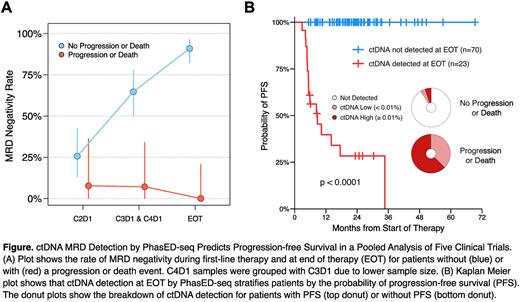Abstract
Background: Current DLBCL response criteria rely on functional radiographic indices, which inherently do not measure disease burden at the molecular level. Prior studies have demonstrated prognostic utility of circulating tumor DNA (ctDNA) quantification in DLBCL before and early after therapy (Roschewski et al. 2015 Lancet Oncol;Kurtz et al. 2018 JCO). However, detection of ctDNA at the end of therapy (EOT) has been challenging using prior approaches that have limits of detection (LOD) in plasma of ~1 part in 10,000 cfDNA molecules (Moding et al. 2021 Cancer Discovery). This is likely because minimal residual disease (MRD) levels at EOT in DLBCL are very low (Kurtz et al. 2021 Nat Biotech; Kumar et al. 2021 Blood 138(S1):58). We assessed the performance of phased variant enrichment and detection by sequencing (PhasED-Seq), an ultrasensitive ctDNA MRD method, with a focus on accurate disease detection at EOT.
Methods: We integrated PhasED-seq MRD data from clinical studies of patients with large B-cell lymphomas and studied associations between MRD-status and clinical outcome data after curative intent first-line (1L) induction therapy. We considered curative-intent anthracycline-based 1L regimens from 5 prospective studies assessing MRD at EOT, including investigational combinations of CHOP or EP[O]CH with acalabrutinib, lenalidomide, obinutuzumab, polatuzumab, and tafasitimab [NCT04002947; NCT00398177; NCT02529852; NCT04231877;NCT04134936]. We compared the predictive value of ctDNA detection to radiographic response and ultimate outcomes including progression free survival (PFS). Cell-free DNA was profiled by PhasED-Seq (Kurtz et al. 2021 Nat Biotech) in the Foresight Diagnostics CLIA laboratory (Aurora, CO) and at Stanford University (Stanford, CA). Tumor or pretreatment plasma and PBMC specimens were used to identify Phased Variants (PVs), and these were used to monitor MRD in subsequent blood specimens collected at interim timepoints (C2D1, C3D1, C4D1), and at the EOT. Patients/samples were reported as MRD positive when ctDNA levels exceeded an analytical detection threshold (~1 part per million cfDNA molecules) corresponding to 98% specificity.
Results: A total of 112 patients were evaluable for both MRD and outcome. 109 patients (97%) were successfully genotyped from plasma or tumor tissue, with blood specimens profiled for 80 patients at pretreatment, 52 at C2D1, 53 at C3D1, 12 at C4D1, and 93 at EOT. As expected for patients with PFS, the MRD-negativity rate increased with each additional cycle of therapy, with 26% MRD negativity at C2D1 compared to 91% at EOT (Fig. A). The clearance of ctDNA after any of the first 3 cycles of 1L therapy was strongly prognostic for PFS (log-rank p=0.0003, Cox HR=15.9). While ctDNA MRD clearance during therapy was prognostic for PFS, lack of clearance by the EOT identified the highest risk group (log-rank p<0.0001, Cox HR > 80, Fig. B). EOT ctDNA detection by PhasED-seq demonstrated 100% sensitivity for identifying PFS events, with lead times up to 30 months. 100% of MRD-negative patients at EOT (n=70) remained without progression with a median follow up of 17 months (range 0-64 months). MRD status during therapy or at EOT remained strongly associated with outcomes in multivariable Cox models after controlling for clinical study (institution, therapy regimen) and ctDNA profiling lab (all p<0.01). Detection of ctDNA MRD at levels below 1 in 10,000 (0.01%) was essential to achieve 100% sensitivity. Specifically, for patients experiencing eventual disease recurrence, 20% and 38% had ctDNA levels below 0.01% during therapy and at EOT, respectively (Fig. B). The ultrasensitive detection of PhasED-seq achieved higher sensitivity than PET/CT at EOT. While PET/CT response at EOT was prognostic for PFS (log-rank p<0.0001, Cox HR=8.5), PET/CT had lower sensitivity compared to PhasED-seq (50% vs 100%, p=0.008) at the same specificity (91%).
Conclusions: Detection of ctDNA MRD via PhasED-Seq is highly prognostic for outcomes in DLBCL, with ctDNA status at the EOT demonstrating the strongest predictive value. Limits of detection below 1 part in 10,000 in clinically feasible plasma volumes are needed to quantify ctDNA MRD, especially at EOT or to achieve performance necessary for use as a surrogate clinical endpoint. Given the potential of ctDNA MRD, clinical trials for DLBCL should routinely collect plasma during therapy and at EOT for the analysis of MRD.
Disclosures
Kurtz:Roche: Consultancy; Adaptive Biotechnologies: Consultancy; Foresight Diagnostics: Consultancy, Current equity holder in private company, Patents & Royalties; Genentech: Consultancy. Westin:Novartis: Consultancy, Research Funding; Calithera: Consultancy, Research Funding; Iksuda: Consultancy; Merck: Consultancy; Genentech/Roche: Consultancy, Research Funding; MorphoSys/Incyte Corporation: Consultancy, Research Funding; Abbvie/GenMab: Consultancy; AstraZeneca: Consultancy, Research Funding; Kite, a Gilead Company: Consultancy, Research Funding; ADC Therapeutics: Consultancy, Research Funding; MonteRosa: Consultancy; Bristol Myers Squibb: Consultancy, Research Funding; SeaGen: Consultancy. Lynch:TG Therapeutics, Incyte, Bayer, Cyteir, Genentech, SeaGen, Rapt: Research Funding; Cancer Study Group: Consultancy. Kuffer:MorphoSys AG: Current Employment, Current equity holder in publicly-traded company. Hogan:Foresight Diagnostics: Current Employment; Freenome: Other: Equity holder. Close:Foresight Diagnostics: Current Employment, Current holder of stock options in a privately-held company. Chabon:Foresight Diagnostics: Current Employment, Current holder of stock options in a privately-held company. Rossi:Gilead: Other: honoraria, advisory board fees , Research Funding; BMS: Consultancy, Honoraria, Other: Travel Support; BeiGene: Consultancy, Honoraria, Other: Travel Support, Research Funding; AbbVie: Consultancy, Honoraria, Other: Travel Support, Research Funding; Janssen: Consultancy, Honoraria, Other: Travel Support, Research Funding; MSD: Other: advisory board fees ; AstraZeneca: Consultancy, Honoraria, Other: Travel Support, Research Funding. Diehn:Foresight Diagnostics: Consultancy, Current equity holder in private company. Alizadeh:Foresight Diagnostics: Consultancy, Current equity holder in private company, Patents & Royalties; Gilead: Consultancy, Divested equity in a private or publicly-traded company in the past 24 months, Patents & Royalties; Syncopation: Current equity holder in private company, Patents & Royalties; Roche: Consultancy; Adaptive Biotechnologies: Consultancy; Karyopharm: Consultancy; BMS: Consultancy, Research Funding; Genentech: Consultancy; Cibermed Inc: Consultancy, Current equity holder in private company, Patents & Royalties. Schultz:Foresight Diagnostics: Current Employment, Current holder of stock options in a privately-held company.
Author notes
Asterisk with author names denotes non-ASH members.


This feature is available to Subscribers Only
Sign In or Create an Account Close Modal